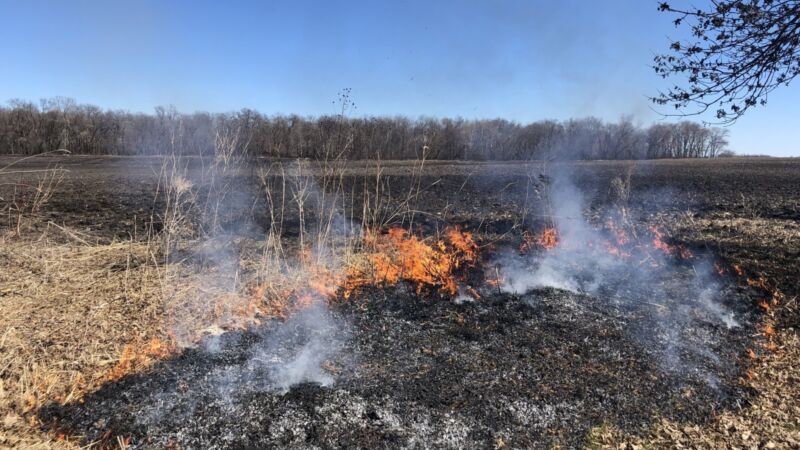
Why Monarchs? While monarchs are intrinsically important, conserving monarchs matters for more than just their own protection. We’re exploring the ways that monarch habitat and conservation helps people, other wildlife and the environment in this ‘More than Monarchs?’ series! Join us to learn more.
Wildfires are a natural component of many ecosystems that serve as a catalyst for promoting biological diversity and healthy plant communities. This article presents an overview of the use and importance of fire in ecosystems across North America. The contents of the article are not relevant for all geographic areas or ecoystems. When fires burn in intervals appropriate to their ecosystem, they can clear out dead and decaying plants that begin to build up on the ground. Nutrients released from the burned material return to the soil, increasing soil fertility and availability to plants. Moreover, periodic fires remove accumulated vegetation and litter that is fuel for more devastating wildfires. The controlled use of fire can provide many positive environmental benefits and has been used as a tool by humans for centuries. Some regions, ecosystems or landscapes are not appropriate for using prescribed fire to promote healthy monarch habitat. This article provides a broad overview of history and use of fire in ecosystem health and should not be applied to all geographies.
However, since the 1980s the extent of area burned by wildfires and the severity of damages has dramatically increased. Since 2010, an average of 6.8 million acres per year have burned, more than double the normal average (National Interagency Fire Center). The 2015 and 2017 fire seasons were the largest with more than 10 million acres burned each year. Human activities have disturbed ecosystems and raised the risk of wildfire in many regions. Extreme weather events, including storms, drought, and prolonged heat waves are also contributing to increased wildfire risk and longer wildfire seasons. These complex interactions driving wildfires coincides with a decades-long severe decline in monarch butterfly populations. Wildfires can damage habitat both in overwintering sites and along the migratory pathways. Larger, more frequent wildfires can remove can both milkweed host plants, and nectar producing plants during critical time periods, while directly killing adult and immature monarchs.
Carefully planned prescribed fire can be an important tool for managing habitat and creating opportunities for nectar plants and milkweed to grow. Burning can reduce fuels and maintain grasslands and open canopy forests with high diversity of flowering plants and shrubs. When timed properly, burning can stimulate milkweed and other grassland species to re-sprout post-fire and be available for adult monarchs. Burning small patches creates mosaics of vegetation structure and enables recolonization of burned areas after the fire. Burning should be avoided on sites where monarch eggs, larvae, pupae, and adults are present. Monitoring prescribed fire and other vegetation management actions is essential to determine whether the treatments are improving monarch habitat and food sources.
The effects of wildfire on monarchs are complicated and cannot be considered as simply good or bad. Native grasslands, prairies, woodlands, and other habitats for monarchs depend on disturbances such as weather events, herbivory, and wildfire to create diversity across the landscape. Without periodic wildfire, in the long term, the quality and amount of these habitats for monarchs will change as various woodlands and forests encroach. Healthy forests and woodlands are essential for pollinator habitat. In ecosystems where it is appropriate, carefully managed prescribed fire can be used as a tool to support health and biodiversity within that system. It is important to note that while prescribed fire can be an important management tool, it can also cause major detriment to some species or if used where it is not appropriate. There are many factors and conditions that need to be considered before deeming prescribed burning appropriate. It is best to always consult with local experts before considering this option for habitat management.
Managing wildfires is just one example of how the work we do for monarchs can make a difference in many ways. What are the co-benefits of monarch conservation that matter most to you? Keep following our “More than Monarchs?” series to hear more stories of what monarchs can do for us, our communities and our world.
Article written by Sean MacDougall of the Bureau of Land Management for the Monarch Joint Venture Communications Working Group and NAPPC Monarch Taskforce’s More than Monarchs Series. The Monarch Joint Venture is a national partnership of federal and state agencies, non-governmental organizations, businesses and academic programs working together to conserve the monarch butterfly migration. The content in this article does not necessarily reflect the positions of all Monarch Joint Venture partners. Header photo by Wendy Caldwell.
